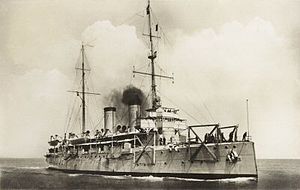 Gelderland
| |
| History | |
|---|---|
| Name | Gelderland |
| Namesake | Gelderland |
| Builder | Maatschappij voor Scheeps- en Werktuigbouw Fijenoord, Rotterdam |
| Laid down | 1 November 1897 |
| Launched | 28 September 1898 |
| Commissioned | 15 July 1900 |
| Decommissioned | 14 May 1940 |
| Fate | Seized by Germany, March 1941 |
| Name | Niobe |
| Namesake | Niobe |
| Commissioned | 1 March 1944 |
| Fate |
|
| General characteristics | |
| Class and type | Holland-class cruiser |
| Displacement | 4,100 t |
| Length | 94.76 m (310.9 ft) |
| Beam | 14.76 m (48.4 ft) |
| Draught | 5.4 m (18 ft) |
| Propulsion |
|
| Speed |
|
| Complement | 397 |
| Sensors and processing systems |
|
| Armament |
|
HNLMS Gelderland (Dutch: Hr.Ms. Gelderland) was a Holland-class protected cruiser of the Royal Netherlands Navy. During its career in the Dutch Navy it was most notable for being the ship Queen Wilhelmina sent to Portuguese East Africa to transport Paul Kruger to Europe during the Second Boer War. The ship was taken over by the Germans during World War II, rebuilt as an anti-aircraft cruiser and renamed Niobe. Commissioned into the German navy on 1 March 1944, she was sunk in Kotka harbour in Finland on 16 July 1944.[1]
- ^ Gröner, Erich (1990). Die deutschen Kriegsschiffe: 1815-1945 / 7 Landungsverbände (2): Landungsfahrzeuge i.e.S. (Teil 2), Landungsfähren, Landungsunterstützungsfahrzeuge, Transporter; Schiffe und Boote des Heeres, Schiffe und Boote der Seeflieger/Luftwaffe, K olonialfahrzeuge. Koblenz: Bernard & Graefe. pp. 214–215. ISBN 3-7637-4807-5.